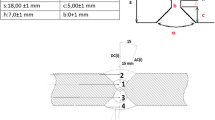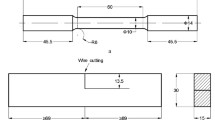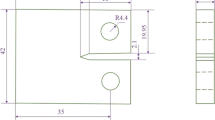Abstract
A series of fracture toughness and fatigue crack growth rate tests were performed on the X70 pipeline steel base and weld metals under 10 MPa of a natural/hydrogen gas mixture with 1% H2 blends. It is observed that the 10 MPa gas mixture with 1% H2 causes a significant reduction in the fracture toughness in both metals. The fatigue crack growth rates are markedly accelerated under the gas mixtures with 1 % hydrogen blend compared with the tests performed in ambient air. The obtained fracture parameters serve as inputs for fatigue life assessment analyses under the effect of a hydrogen-containing environment. The observed design fatigue life depends strongly only on the environmental conditions. The design fatigue strength of the structural pipeline exposed to hydrogen is much shorter than that under ambient air owing to the decrease in fracture toughness properties and acceleration of the fatigue crack growth rate.
Similar content being viewed by others
Abbreviations
- a :
-
Crack depth
- a o :
-
Initial crack depth
- a Crtical :
-
Critical crack depth
- C :
-
Fatigue crack growth coefficient
- c :
-
Half of crack length
- CTOD :
-
Crack tip opening displacement
- F :
-
Boundary correction
- FCGR :
-
Fatigue crack growth rate
- K :
-
Stress intensity factor for mode I crack
- K IC :
-
Fracture toughness
- m :
-
Fatigue crack growth exponent
- P :
-
Internal pressure
- Q :
-
Shape factor
- R i :
-
Inner radius of cylinder
- R m :
-
Mean radius of cylinder
- R o :
-
Outer radius of cylinder
- t :
-
Wall thickness of cylinder
- σ :
-
Stress and stress rate, respectively
- σ h :
-
Hoop stress in cylinder
- σ r :
-
Axial stress in cylinder
References
E. J. Moniz, H. D. Jacoby, A. J. Meggs, R. C. Armtrong, D. R. Cohn, S. R. Connors and G. M. Kaufman, The Future of Natural Gas, Cambridge, MA: Massachusetts Institute of Technology (2011).
J. G. Speight, Natural Gas: A Basic Handbook, Gulf Professional Publishing (2018).
D. Hardie, E. A. Charles and A. H. Lopez, Hydrogen embrittlement of high strength pipeline steels, Corros. Sci., 48 (2006) 4378–4385.
Y. Zhao and M. Song, Failure analysis of a natural gas pipeline, Eng. Fail. Anal., 63 (2016) 61–71.
E. S. Meresht, T. S. Farahani and J. Neshati, Failure analysis of stress corrosion cracking occurred in a gas transmission steel pipeline, Eng. Fail. Anal., 18 (2011) 963–970.
H. B. Xue and Y. F. Cheng, Characterization of inclusions of X80 pipeline steel and its correlation with hydrogen-induced cracking, Corros. Sci., 53 (2011) 1201–1208.
G. Ghosh, P. Rostron, R. Garg and A. Panday, Hydrogen induced cracking of pipeline and pressure vessel steels: a review, Eng. Fract. Mech., 199 (2018) 609–618.
A. Mustapha, E. A. Charles and D. Hardie, Evaluation of environment-assisted cracking susceptibility of a grade X100 pipeline steel, Corros. Sci., 54 (2012) 5–9.
B. P. Somerday, P. Sofronis, K. A. Nibur, C. San Marchi and R. Kirchheim, Elucidating the variables affecting accelerated fatigue crack growth of steels in hydrogen gas with low oxygen concentrations, Acta Mater., 61 (2013) 6153–6170.
H. J. Cialone and J. H. Holbrook, Effects of gaseous hydrogen on fatigue crack growth in pipeline steel, Metall. Trans. A, 16 (1985) 115–122.
I. Moro, L. Briottet, P. Lemoine, E. Andrieu, C. Blanc and G. Odemer, Hydrogen embrittlement susceptibility of a high strength steel X80, Mater. Sci. Eng. A, 527 (2010) 7252–7260.
L. Gan, F. Huang, X. Zhao, J. Liu and Y. F. Cheng, Hydrogen trapping and hydrogen induced cracking of welded X100 pipeline steel in H2S environments, Int. J. Hydrogen Energy, 43 (2018) 2293–2306.
R. L. Eadie, K. E. Szklarz and R. L. Sutherby, Corrosion fatigue and near-neutral pH stress corrosion cracking of pipeline steel and the effect of hydrogen sulfide, Corrosion, 61 (2005) 167–173.
M. C. Zhao, M. Liu, A. Atrens, Y. Y. Shan and K. Yang, Effect of applied stress and microstructure on sulfide stress cracking resistance of pipeline steels subject to hydrogen sulfide, Mater. Sci. Eng. A, 478 (2008) 43–47.
C. San Marchi, B. P. Somerday, K. A. Nibur, D. G. Stalheim, T. Boggess and S. Jansto, Fracture and fatigue of commercial grade API pipeline steels in gaseous hydrogen, Proceedings from ASME 2010 Pressure Vessels and Piping Division, Bellevue, Washington, USA (2010).
L. Briottet, R. Batisse, G. de Dinechin, P. Langloi and L. Thiers, Recommendations on X80 steel for the design of hydrogen gas transmission pipelines, Int. J. Hydrogen Energy, 37 (2012) 9423–9430.
C. Azevedo, Failure analysis of a crude oil pipeline, Eng. Fail. Anal., 14 (2007) 978–994.
S. P. Lynch, Failures of structures and components by envirnomentally assisted cracking, Eng. Fail. Anal., 1 (1994) 77–90.
M. Dadfarnia, P. Sofronis, J. Brouwer and S. Sosa, Assessment of resistance to fatigue crack growth of natural gas line pipe steels carrying gas mixed with hydrogen, Int. J. Hydrogen Energy, 44 (2019) 10808–10822.
J. Capelle, J. Gilgert, I. Dmytrakh and G. Pluvinage, The effect of hydrogen concentration on fracture of pipeline steels in presence of a notch, Eng. Fract. Mech., 78 (2011) 364–373.
R. Rebak, Z. B. Xia, R. Safruddin and Z. Szklarska-Smialowska, Effect of solution composition and electrochemical potential on stress corrosion cracking of X-52 pipeline steel, Corrosion, 52 (1996) 396–405.
A. Díaz, J. M. Alegr and I. I. Cuesta, Numerical simulation of hydrogen embrittlement and local triaxiality effects in notched specimens, Theoretical and Applied Fracture Mechanics, 90 (2017) 294–302.
M. Wang, E. Akiyam and K. Tsuzaki, Effect of hydrogen and stress concentration on the notch tensile strength of AISI 4135 steel, Mater. Sci. Eng. A, 398 (2005) 37–46.
K. Ma, Z. Hua, C. Gu, Z. Zhang, S. Ye and Y. Yao, Effects of crack position on fatigue life of large seamless storage vessels made of 4130X for hydrogen refueling station, Int. J. Hydrogen Energy, 44 (2019) 22559–22568.
Z. Li, X. Jiang, H. Hopman, L. Zhu and Z. Liu, An investigation on the circumferential surface crack growth in steel pipes subjected to fatigue bending, Theoretical and Applied Fracture Mechanics, 105 (2020) 102403.
Z. Li, X. Jiang, H. Hopman, L. Zhu and Z. Liu, External surface cracked offshore steel pipes reinforced with composite repair system subjected to cyclic bending: an experimental investigation, Theoretical and Applied Fracture Mechanics, 109 (2020) 102703.
ISO 12135: 2002, Metallic Materials-unified Method of Test for the Determination of Quasistatic Fracture Toughness, International Organization for Standardization (ISO) (2002).
ASTM E647-15, Standard Test Method for Measurement of Fatigue Crack Growth Rates, ASTM International (2015).
T. T. Nguyen, J. Park, W. S. Kim, S. H. Nahm and U. B. Beak, Effect of low partial hydrogen in a mixture with methane on the mechanical properties of X70 pipeline steel, Int. J. Hydrogen Energy, 45 (2020) 2368–2381.
U. B. Beak, T. T. Nguyen, J. Park, W. S. Kim and S. H. Nahm, Hydrogen-induced fracture of X70 pipeline steel base/weld under natural/hydrogen gas mixture condition, ASME 2020 Pressure Vessels and Piping Conference, American Society of Mechanical Engineers, PVP2011–21361.
G. Álvarez, A. Zafra, F. J. Belzunce and C. Rodríguez, Hydrogen embrittlement analysis in a CrMoV steel by means of sent specimens, Theoretical and Applied Fracture Mechanics, 106 (2020) 102450.
L. B. Peral, A. Zafra, J. Belzunce and C. Rodríguez, Effects of hydrogen on the fracture toughness of CrMo and CrMoV steels quenched and tempered at different temperatures, Int. J. Hydrogen Energy, 44 (2019) 3953–3965.
Y. Ogawa, H. Matsunaga, J. Yamabe, M. Yoshikawa and S. Matsuoka, Unified evaluation of hydrogen-induced crack growth in fatigue tests and fracture toughness tests of a carbon steel, Int. J. Fatigue, 103 (2017) 223–233.
U. B. Baek, H. M. Lee, S. W. Baek and S. H. Nahm, Hydrogen embrittlement for X-70 pipeline steel in high pressure hydrogen gas, ASME 2015 Pressure Vessels and Piping Conference, American Society of Mechanical Engineers, PVP2015–45475.
S. Lynch, Discussion of some recent literature on hydrogen-embrittlement mechanisms: addressing common misunderstandings, Corrosion Reviews, 37 (2019) 377–395.
D. Birenis, Y. Ogawa, H. Matsunaga, O. Takakuwa, J. Yamabe, Ø. Prytz and A. Thøgersen, Interpretation of hydrogen-assisted fatigue crack propagation in BCC iron based on dislocation structure evolution around the crack wake, Acta Mater., 156 (2018) 245–253.
A. Nagao, C. D. Smith, M. Dadfarnia, P. Sofronis and I. M. Robertson, The role of hydrogen in hydrogen embrittlement fracture of lath martensitic steel, Acta Mater., 60 (2012) 5182–5189.
KHKS 0220:2008. Standard for Superhigh-pressure Gas Equipment, Tokyo, Japan (2008).
ASME Section VIII, Division 3 Code, 2007 Edition, Article Corsica, France. KD-10, Special Requirements for Vessels in High Pressure Gaseous Hydrogen Transport and Storage service, ASME, New York, NY.
K. B. Yoon, T. G. Park and A. Saxena, Creep crack growth analysis of elliptic surface cracks in pressure vessels, Int. J. of Pressure Vessels and Piping, 80 (2003) 465–479.
N. N. Tun, H. S. Yang, J. M. Yu and K. B. Yoon, Creep crack growth analysis using C t-parameter for internal circumferential and external axial surface cracks in a pressurized cylinder, Journal of Mechanical Science and Technology, 30 (2016) 5447–5458.
B. Zakavi, A. Kotousov, A. Khanna and R. Branco, A new method for analysis of part-elliptical surface cracks in structures subjected to fatigue loading, Theoretical and Applied Fracture Mechanics, 103 (2019) 102258.
S. Raju and J. C. Newman, Stress intensity factors for internal and external surface cracks in cylindrical vessels, Journal of Pressure Vessel Technology, 104 (1982) 293–298.
J. Newman Jr., and I. Raju, An empirical stress-intensity factor equation for the surface crack, Eng. Fract. Mech., 15 (1981) 185–192.
A. Zahoor, Research Project 1757–69, Ductile Fracture Handbook, Electric Power Research Institute (1990).
ASME B 31.8, Gas Transmission and Distribution Piping System, New York: American Society of Mechanical Engineers (2004).
C. Yang and J. Ogden, Determining the lowest-cost hydrogen delivery mode, Int. J. Hydrogen Energy, 32 (2007) 268–286.
T. T. Nguyen, J. S. Park, W. S. Kim, S. H. Nahm and U. B. Beak, Environment hydrogen embrittlement of pipeline steel X70 under various gas mixture conditions with in situ small punch tests, Mater. Sci. Eng. A (2020) 139114.
H. Matsunaga, M. Yoshikaw, R. Kondo, J. Yamabe and S. Matsuoka, Slow strain rate tensile and fatigue properties of Cr-Mo and carbon steels in a 115 MPa hydrogen gas atmosphere, Int. J. Hydrogen Energy, 40 (2015) 5739–5748.
J. Ronevich, C. San Marchi, R. Kolasinski, K. Thurmer, N. Bartelt, F. El Gabaly and B. Somerday, Oxygen impurity effects on hydrogen assisted fatigue and fracture of X100 pipeline steel, Pressure Vessels and Piping Conference, American Society of Mechanical Engineers, 51685 (2018) V06BT06A027.
Acknowledgments
This research was supported by Development of Reliability Measurement Technology for Hydrogen Refueling Station funded by Korea Research Institute of Standards and Science (KRISS-2020-GP2020-0007).
Author information
Authors and Affiliations
Corresponding author
Additional information
Recommended by Editor Chongdu Cho
Thanh Tuan Nguyen received his Ph.D. in Mechanical Engineering from Chung-Ang University, Korea in 2018. He is currently working as a post-doctoral fellow at the Korea Research Institute of Standard and Science. His research interests are failure analysis, high-temperature fracture mechanics and the effect of gaseous hydrogen environments on the mechanical properties of materials.
Hyeong Min Heo received his Ph.D. in Material Science Engineering from Han Yang University, Korea in 2019. He is currently working as Senior Researcher at the Korea Research Institute of Standard and Science. His research interests are material characterizations and the mechanical behaviour of materials under the effect of hydrogen gas.
Jaeyeong Park received his Ph.D. in Material Science Engineering from Pohang University of Science and Technology, Korea in 2018. He is currently working as Senior Researcher at the Korea Research Institute of Standard and Science. His research interests are materials science and the mechanical behaviour of materials at high temperature, including anisotropic materials such as gas turbine blades.
Seung Hoon Nahm received his Ph.D. in Mechanical Engineering from Kyungpook National University, Korea in 1997. He is currently working as Principal Research Scientist at the Korea Research Institute of Standard and Science. His research interests are the mechanical behaviour of materials at the micro and nano-scales, hydrogen embrittlement and mechanical behaviour of materials at high temperature.
Un Bong Baek received his Ph.D. in Mechanical Engineering from Kyungpook National University in 2001. He worked at Georgia Institute of Technology, U.S.A. as a post-doctoral fellow during 2002–2003. Dr. Baek is currently Director of the Centre for Energy and Material Metrology of KRISS (Korea Research Institute of Standards and Science). His research interest is in the mechanical behaviour of materials in high-pressure hydrogen environments.
Rights and permissions
About this article
Cite this article
Nguyen, T.T., Heo, H.M., Park, J. et al. Fracture properties and fatigue life assessment of API X70 pipeline steel under the effect of an environment containing hydrogen. J Mech Sci Technol 35, 1445–1455 (2021). https://doi.org/10.1007/s12206-021-0310-0
Received:
Revised:
Accepted:
Published:
Issue Date:
DOI: https://doi.org/10.1007/s12206-021-0310-0




